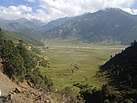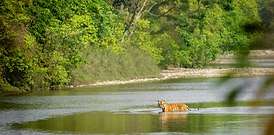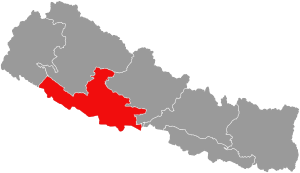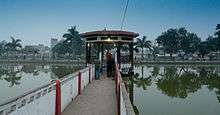Province No. 5
| Province No. 5 प्रदेश न० ५ | |
|---|---|
| Province | |
.jpg)    From Top left to right Maya Devi Temple at Lumbini, Dhorpatan Hunting Reserve, Ranighat Palace, Bageshwori Temple and a Bengal tiger at Bardiya National Park | |
 Location of Province No. 5 | |
 | |
| Country |
|
| Formation | 20 September 2015 |
| Capital city (Temporary) | Butwal |
| Largest city | Ghorahi |
| Districts | 12 |
| Government | |
| • Body | Government of Province No. 5 |
| • Governor | Umakanta Jha |
| • Chief Minister | Shankar Pokharel (NCP) |
| • High Court | Tulsipur High Court |
| • Provincial Assembly | Unicameral (87 seats) |
| • Parliamentary constituency | 26 |
| Area | |
| • Total | 22,288 km2 (8,605 sq mi) |
| Area rank | 3rd |
| Population | |
| • Total | 4,499,272 |
| • Rank | 4th |
| • Density | 200/km2 (520/sq mi) |
| • Density rank | 3rd |
| Time zone | UTC+5:45 (NST) |
| Geocode | NP-FI |
| Main Official Language | Nepali (51.6%) |
| Other Official Language(s) |
1. Tharu (12.26%) 2. Awadhi (10.18%) . |
| HDI | 0.519 (low) |
| Literacy | 66.43% |
| Sex ratio | 90.43 ♂ /100 ♀ (2011) |
| Website | http://pradesh-5.com/ |
Province No. 5 (proposed name: Lumbini)[1] is one of the seven provinces established by the new constitution of Nepal which was adopted on 20 September 2015.[1] As per a 17 January 2018 cabinet meeting, the city of Butwal has been declared the interim state capital of Province No. 5. It borders Gandaki Pradesh and Karnali Pradesh to the north, Sudurpashchim Pradesh to the west, and Uttar Pradesh of India to the south.
Government and administration
The Governor acts as the head of the province while the Chief Minister is the head of the provincial government. The Chief Judge of the Tulsipur High Court is the head of the judiciary.[2] The present Governor, Chief Minister and Chief Judge are Uma Kanta Jha (governor), Shankar Pokhrel (chief minister) and Nahakul Subedi.[3][4] The province has 87 provincial assembly constituencies and 26 House of Representative constituencies.[5]
Province No. 5 has a unicameral legislature, like all of the other provinces in Nepal. The term length of provincial assembly is five years. The Provincial Assembly of Province No. 5 is temporarily housed at the Chamber of Commerce Meeting Hall in Butwal.[6]
Administrative subdivisions
Province No. 5 is divided into 12 districts, which are listed below. A district is administrated by the head of the District Coordination Committee and the District Administration Officer. The districts are further dived to municipalities or rural municipalities. The municipalities include four sub-metropolitan cities and 32 municipalities. There are 73 rural municipalities in the province.[7]
- Arghakhanchi District
- Banke District
- Bardiya District
- Dang District
- Eastern Rukum District
- Gulmi District
- Kapilvastu District
- Parasi District
- Palpa District
- Pyuthan District
- Rolpa District
- Rupandehi District
| Rank | District | Pop. | Rank | District | Pop. | ||||
|---|---|---|---|---|---|---|---|---|---|
 Ghorahi |
1 | Ghorahi | Dang | 156,164 | 11 | Shivaraj | Kapilvastu | 66,781 |  Nepalgunj  Butwal |
| 2 | Tulsipur | Dang | 141,528 | 12 | Gulariya | Bardiya | 66,679 | ||
| 3 | Nepalgunj | Banke | 138,951 | 13 | Buddhabhumi | Kapilvastu | 64,949 | ||
| 4 | Butwal | Rupandehi | 138,741 | 14 | Siddharthanagar | Rupandehi | 63,483 | ||
| 5 | Tilottama | Rupandehi | 100,149 | 15 | Krishnanagar | Kapilvastu | 65,602 | ||
| 6 | Kapilvastu | Kapilvastu | 76,394 | 16 | Rajapur | Bardiya | 59,553 | ||
| 7 | Banganga | Kapilvastu | 75,242 | 17 | Ramgram | Nawalparasi West | 59,455 | ||
| 8 | Lumbini Sanskritik | Rupandehi | 72,497 | 18 | Bansgadhi | Bardiya | 55,875 | ||
| 9 | Kohalpur | Banke | 70,647 | 19 | Sainamaina | Rupandehi | 55,822 | ||
| 10 | Barbardiya | Bardiya | 68,012 | 20 | Sunwal | Nawalparasi West | 55,424 | ||
See Also
References
- 1 2 "Nepal Provinces". statoids.com. Retrieved 2016-03-21.
- ↑ "High Courts get their chief judges". Retrieved 2018-04-27.
- ↑ "Shankar Pokharel appointed Province 5 CM". The Himalayan Times. 2018-02-14. Retrieved 2018-04-27.
- ↑ "President of Nepal administers oath to Chiefs of seven provinces | DD News". ddnews.gov.in. Retrieved 2018-04-27.
- ↑ "CDC creates 495 constituencies". The Himalayan Times. 2017-08-31. Retrieved 2018-04-27.
- ↑ "First Provincial Assembly meet of Province no 5 begins". Retrieved 2018-04-27.
- ↑ "स्थानिय तह". 103.69.124.141. Retrieved 2018-04-27.
